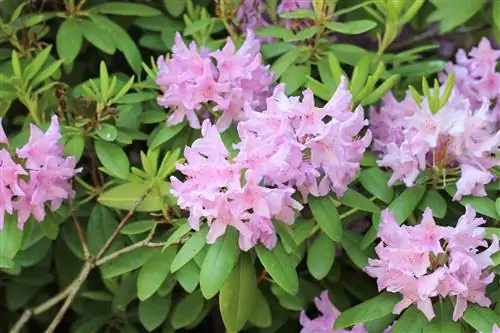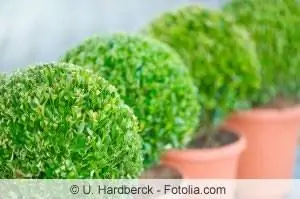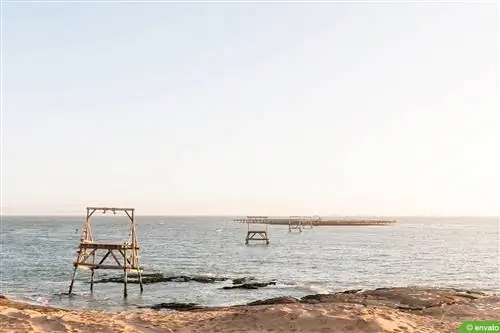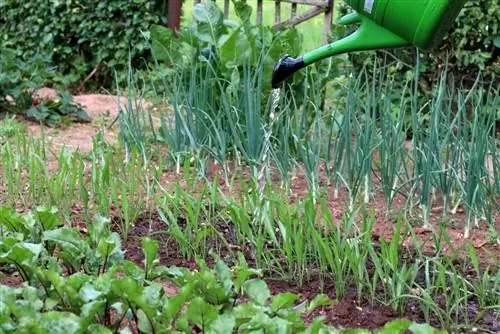- Author admin [email protected].
- Public 2023-12-17 03:39.
- Last modified 2025-06-01 06:48.
The flowers and leaves of the rhododendron require a regular and appropriate supply of nutrients. In the short term and in the long term, otherwise the fluctuations can disrupt growth, lead to oversupply or even chemical burns on the roots. When deciding on a product, hobby gardeners should pay close attention to the composition and be informed about its effects. Of course, this also applies if you want to mix and use your own resources.
Needs
The rhododendron only has a relatively small root ball. The roots run shallowly underground and do not spread significantly. On the one hand, this means that they cannot cause any damage and they do not disturb nearby plants or become competitors. Advantages that are particularly important in small gardens or where there is dense vegetation. However, the rhododendron can hardly support itself due to its limited spread. Local and targeted fertilization therefore becomes crucial. It is therefore a good idea to add the fertilizer to the irrigation water if necessary and thus bring it directly to the roots.
Time
The end of March or beginning of April is recommended as the time to fertilize the rhododendron. So the beginning of the growth phase. The product you choose then determines when additional nutrients need to be added again. As a rule, the end of flowering is a good time for the second dose. For products with a long-term effect, fertilization is only carried out once more in June or July. However, hobby gardeners should follow the manufacturer's instructions. The same applies to the quantity and dosage of the respective product.
Tip:
You should stop fertilizing in September at the latest so that the rhododendron can prepare for winter in time.
Soil and pH
Most rhododendron species grow best in a sandy loam soil that can hold water well and is still permeable. Just as important as the nature of the substrate for the ericaceous plant is its pH value. Although there are exceptions, most rhododendron species require acidic soil with a pH value below 6. From 6 onwards, growth becomes significantly weaker or even stops completely. You can no longer expect flowers. Since the pH value can change over time, it should not only be checked and adjusted during planting. Instead, a soil sample should be taken in the immediate vicinity of the rhododendron at least once a year and tested. Other land values can also be determined on this occasion.
The meaning and connection to fertilization can be found in the minerals and nutrients that are already present and are important for the crop. Only if these are known can the rhododendron be fertilized accordingly and in a coordinated manner. In addition, a neutral or even too alkaline substrate can prevent the absorption of nutrients. Even if the soil contains everything needed or with a good product that is specifically suitable for rhododendrons etc., no success can be achieved.
Funds and products
Due to the special needs of the rhododendron, the use of a rhododendron fertilizer is recommended. These can be found in large numbers on the market and often have a long-term and multiple effect. This is achieved through a favorable mixture of organic and mineral components. The following products are recommended:
- Hauer Rhododendron fertilizer
- Substral rhododendron fertilizer
- Neudroff Azet rhododendron fertilizer
- Beckmann in the garden rhododendron fertilizer
- Compo hydrangea, azalea, camellia and rhododendron fertilizer
All of these products are specifically designed to provide care for ericaceous plants and are therefore composed accordingly.
Tips for choosing
If you are still unsure about choosing the right fertilizer for your rhododendron, you should simply pay attention to the following points. If the pH value tends to be high, choose a product with a pH-lowering or soil-acidifying effect. The Rhodo-Vital substral floor treatment is particularly suitable here. Overall, the fertilizer should be low in s alt, contain organic and mineral active ingredients and be easy to dose. Spreadable granules and liquid agents, such as Compo hydrangea, azalea, camellia and rhododendron fertilizer.
Effect of the substances
- Nitrogen - Nitrogen is better known for its harmful he alth effects in humans, but for plants it is a vital main nutrient and is largely responsible for growth. If the rhododendron does not grow despite the right pH value, nitrogen can help it along.
- Phosphor - Phosphorus is also a so-called macronutrient and is significantly involved in flower formation and flowering power.
- Potassium - Potassium is the third and final main nutrient found in complete fertilizers. Its effect is particularly noticeable in the general resistance of the plant.
- Magnesium - Although required in smaller quantities, magnesium is also important for the survival of the rhododendron. As a building block in chlorophyll, it is involved in photosynthesis. If it is missing, the plant lacks strength.
- Sodium - Supplying sodium must be done very carefully. On the one hand, it promotes growth and can be used as a substitute in the event of a potassium deficiency by the plant. On the other hand, an oversupply can lead to the plant dying very quickly. Especially with rhododendrons, it is important to pay attention to low-s alt products for fertilization.
- Sulfur - The plant needs this micronutrient in small amounts in order to be able to convert and use the nitrogen accordingly. Sulfur is also indirectly involved in growth.
- Iron - If the leaves turn pale or yellowish, this is often due to a lack of iron. This serves as a catalyst in some processes and is also responsible for the formation of the strong green leaves.
Compensatory fertilization
In finished products for rhododendron fertilization, the nutrients are tailored to the needs of the plants and are present in a balanced ratio. However, if the soil itself is not in balance, but is specifically lacking in a nutrient, the deficit will remain even after fertilization.
Compensatory fertilization or soil treatment is then required. Of course, such a deficiency can only be detected if regular soil samples are tested. Deficiencies are compensated for by products that contain a lot of the respective nutrient. For example, kieserite is suitable for supplying magnesium, whereas blue grain is particularly suitable for potassium levels that are too low.
Conclusion of the editors
Supplying the rhododendron with additional nutrients is usually not complicated, but is absolutely necessary because the plant cannot sufficiently supply itself. If you regularly use special rhododendron fertilizer and test the soil, you can enjoy your plants for a long time. Dangerous deficits and imbalances in nutrients can then be identified more quickly and remedied more easily.
What you should know about rhododendron fertilizer in brief
- Rhododendrons like it moist, so it is advisable to spread the fertilizer around the plant and then water it thoroughly.
- The fertilizer can also be added directly to the irrigation water.
- In any case, if it is to be added directly to the ground, it should only be worked in shallowly.
- In general, rhododendrons have very shallow roots and would otherwise be damaged.
- Special mineral fertilizers with a long-term effect are ideal. They gradually release their active ingredients into the plant.
- The fertilizer should contain phosphate and iron. Magnesium and sulfur ensure deep green leaves.
- Fertilization should begin in early spring.
- When planting new plants, fertilization has a good initial effect.
- However, not for autumn plantings: Fertilization should not begin until next spring.
Many rhododendron fertilizers also have organic components that have a humus-forming effect, which has a positive effect on the growth of the plant. Important trace elements contained in the fertilizer act as a breeding ground for the microorganisms in the soil.
- The fertilizer should be low in s alt so that the rhododendrons remain he althy and resilient and have beautiful flowers.
- If brown leaf edges appear on the rhododendron, this is often a sign of potassium deficiency.
- Then the fertilizer should definitely contain a proportion of potassium. This also increases resistance to drought and frost.
Tip:
Because of its many positive properties, rhododendron fertilizer is also suitable for many other plants. The nutrients are also valued by heather plants, fuchsias and blueberries and also help them to produce abundant flowers and he althy growth.






